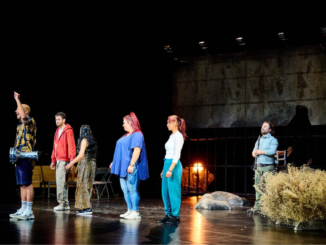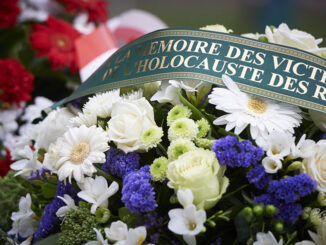The series of OHTE webinars continued on 14 April 2022 on the topic of minority history, with a focus on the case of Roma and on the role of the Observatory in providing an overview of the state of history teaching, including that of minorities.
Co-organised by the Observatory on History Teaching in Europe and the Roma and Travellers Team of the Council of Europe, the webinar on “Teaching the History of Minorities in Europe : the Case of Roma History” brought together some 60 participants online and was lauded for the rich contribution of each speaker – particularly in providing examples of good practices and providing resources for ensuring the teaching of history of the Roma minority in an inclusive and participatory manner.
We need to have strong and competent teachers who are creative and open enough to be able to bring content into everyday classroom situations. The curriculum in Serbia does not provide content or specific topics, but it states the outcomes – meaning the skills, knowledge and values that students have to know at the end of the school year. What teachers do within the curricula is what is most important for us. When we talk about content regarding minority history, including Roma language and culture, we prefer to talk about how we can provide courses, materials and resources for teachers that are ready for classrooms, with steps designed on how to use them.
mentioned Ms Anamarija Viček, State Secretary within the Ministry of Education, Science and Technological Development of Serbia and Bureau Member of the Observatory’s Governing Board, highlighting the need for resources in supporting teachers to deliver lessons that are respectful of Council of Europe standards and recommendations on history teaching.
Without necessarily making recommendations, the Observatory is laying down the ground work for collecting data across the member states regarding, among other things, the teaching of minority history and the teaching of Roma history.
There are resources, there is knowledge, there is a critical mass of scholars, historians, of Roma students, PhDs that come from the community – so there is a layer of sensitivity and critical reflection towards historical content when we look or read into historical materials or sources which contain bias. There is a lot that we can build on, and what is needed is a co-ordinated push. This is why both the Council of Europe recommendation and the work of the Observatory are important, which tries to bring in multiple sources of knowledge on one platform and facilitate exchange across countries so that we can build a narrative of Roma history that is – as our people are – transnational and intertwined in histories and geographies across Europe.
underlined Anna Mirga-Kruszelnicka, Deputy Director of the European Roma Institute for Arts and Culture, a joint initiative of the Council of Europe, the Open Society Foundations, and the Alliance for the European Roma Institute that produced a number of high quality multimedia resources (listed below) related to Roma history, including their acts of resistance during the Second World War. Ms Mirga- Kruszelnicka further mentioned good practices from Spain in the development of textbooks that are sensitive and inclusive of Roma, and that were elaborated in a participatory manner – with contributions from Roma authors. She also referred to the study conducted in 2020 by the Leibniz Institute for Educational Media | Georg Eckert Institute in co-operation with Roma Education Fund and the Roma and Travellers Team of the Council of Europe as a good way to gain reliable insights on how minorities are represented in textbooks, and what children – majority or minority – learn about their peers and themselves
There are resources, there is knowledge, there is a critical mass of scholars, historians, of Roma students, PhDs that come from the community
A new joint project of the European Union and Council of Europe – HISTOLAB (Transnational History Education and Cooperation Laboratory) – will also seek in the coming months and years to pool knowledge related to history teaching, including the history of minorities, within a digital resource hub.
The Council of Europe has done already a lot in terms of promoting the history of minorities and the Observatory itself has as one of its goals drawing attention to the importance of history teaching of minorities and Roma history. [Governments] would benefit from partnerships with non-governmental organisations, with civil society initiatives of the type that ERIAC represents, but also with academics involved in scholarship on minority histories, on Roma histories. These kind of participatory curriculum development is the way ahead to a type of history teaching that is more inclusive and also more responsive to the needs of societies
complemented Dr Raul Cârstocea, lecturer at Maynooth University and Vice-Chair of the Observatory’s Scientific Advisory Council. He also mentioned the role of the Observatory in “improving the current state of what we know about minority history and the teaching of minority history generally. The Observatory carries out longitudinal reports across member states (regular and thematic reports). The first thematic report will focus on the teaching of pandemics and natural disasters in history […] and we have a chapter of that report that talks about the scapegoating of minority groups in the context of pandemics. When it comes to the regular report, one of the things we asked is the extent to which the history of minorities in different countries are taught and how they are taught: as part of the main curriculum or separately, as part of the compulsory curriculum or as optional parts of the curriculum, and are they taught in the entire country, or are they only taught in regions that have significant minority groups?”. Without necessarily making recommendations, the Observatory is laying down the ground work for collecting data across the member states regarding, among other things, the teaching of minority history and the teaching of Roma history. This kind of data can then be used for further recommendations by the Council of Europe.
What brings unity among citizens is, among others, the affective bond based on shared history. This means that un-shared history might generate clashes. This is why the role of history teaching is also to resolve these clashes; knowing each other’s history can provide answers to contemporary challenges; can turn hatred and misinformation to respect, knowledge and understanding
concluded Ms Taba, Senior Project Officer within the Roma and Travellers Team of the Council of Europe.
Full video of the webinar here.
Video extracts of the discussions will be made available on our Twitter and Facebook accounts.
Resources mentioned during the webinar:
- CM/Rec(2020)2 on the inclusion of the history of Roma and/or Travellers in school curricula and teaching materials
- Roma History Factsheets
- The Representation of Roma in European Curricula and Textbooks. Analytical Report (in cooperation with Leibniz Institute for Educational Media | Georg Eckert Institute)
- CM/Rec(2001)15 on history teaching in twentyfirst-century Europe
- CM/Rec(2011)6 on intercultural dialogue and the image of the other in history teaching
- Reference Framework of Competences for Democratic culture
- Right to Remember – A handbook for Education with Young People on the Roma Genocide.
- Barabaripen Young Roma Speak About Discrimination
- Roma Voices in History – A sourcebook
- ERIAC’s Barvalipe Roma Online University (English & national language courses)
- ERIAC’s Re-thinking Roma Resistance
Källa: coe.int
Redaktionen
redaktionen@dikko.nu
Att vara en oberoende tidning kostar pengar så vill du hjälpa oss med att betala vårt fika får du gärna swisha en slant till 123 242 83 40 eller bg: 5534-0046
Vill du annonsera eller sponsra, synas eller höras i våra media?
Kontakta oss på redaktionen@dikko.nu
eller ring 0768 44 51 61
IBAN: SE19 9500 0099 6042 1813 4395
BIC: NDEASESS




